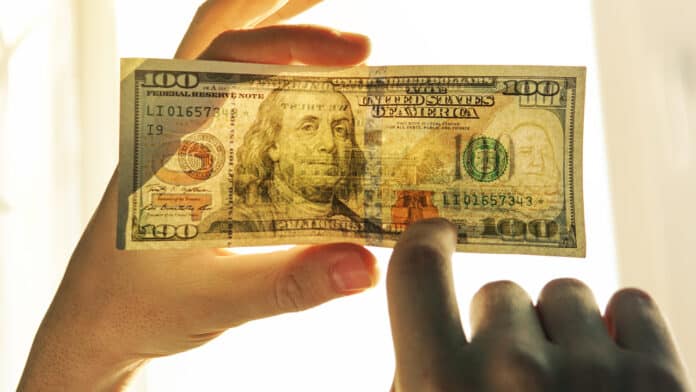what to do if i find fake currencies

Though UV counterfeit detection lamps and counterfeit money pens are helpful tools, there are many other ways to tell if a pecker is accurate or counterfeit. Physical characteristics of the banknote, such equally ink, watermarks, and text, are intentional security measures to assistance people recognize authentic money.
When retail associates learn how to spot a fake $100 bill, they can help reduce the chances of a business concern suffering a loss of thousands of dollars. Hither is a list of eight ways to tell if a bill is real or counterfeit:
1. Color-shifting Ink
Ane of the first things to check to see if a bill is authentic is if the pecker denomination on the bottom right-hand corner has color-shifting ink. Going back to 1996, all bills of $5 or more have this security feature. If you hold a new series neb (except for the new $five beak) and tilt it back and along, yous tin can see that the numeral in the lower right-manus corner shifts from light-green to black or from gold to dark-green.
2. Watermark
The watermark is a feature security feature of authentic banknotes. Many of the new bills use a watermark that is actually a replica of the face on the pecker. On other banknotes, it is merely an oval spot. Here are some things to keep in mind when looking at a bill's watermark:
• The watermark should only be visible when you hold the bill up to the light.
• The watermark should be on the right side of the bill.
• If the watermark is a confront, it should exactly match the face on the pecker. Sometimes counterfeits bleach lower bills and reprint them with higher values, in which instance the face wouldn't match the watermark.
• If there is no watermark or the watermark is visible without being held up to the lite, the bill is most likely a counterfeit.
3. Blurry Borders, Printing, or Text
An automated red flag for counterfeit bills is noticeably blurry borders, printing, or text on the bill. Authentic bills are made using dice-cutting press plates that create impressively fine lines, and so they look extremely detailed. Counterfeit printers are ordinarily not capable of the same level of detail. Accept a close look, specially at the borders, to see if there are any blurred parts in the bill. Authentic banknotes likewise have microprinting, or finely printed text located in diverse places on the bill. If the microprinting is unreadable, even under a magnifying glass, it is probably counterfeit.
4. Raised Press
All authentic banknotes have raised printing, which is difficult for counterfeiters to reproduce. To discover raised printing, run your fingernail carefully down the notation. You should feel some vibration on your nail from the ridges of the raised printing. If you don't experience this texture, then yous should check the pecker further.
5. Security Thread with Microprinting
The security thread is a thin imbedded strip running from top to bottom on the face up of a banknote. In the $10 and $50 bills the security strip is located to the right of the portrait, and in the $five, $20, and $100 bills it is located just to the left.
Authentic bills have microprinting in the security thread every bit another layer of security. Beneath is a listing of the microprinted phrases on authentic banknotes:
• $five nib says "Usa V"
• $10 nib says "The states TEN"
• $20 beak says "U.s. TWENTY"
• $fifty bill says "USA fifty"
• $100 bill says "USA 100"
vi. Ultraviolet Glow
Counterfeit detection tools and technology apply ultraviolet light considering this is a clear-cut fashion of telling if a bill is apocryphal. The security thread on authentic bills glow nether ultraviolet light in the following colors:
• $five bill glows bluish
• $10 bill glows orange
• $20 nib glows green
• $50 bill glows xanthous
• $100 bill glows red/pink
7. Cherry and Blue Threads
If you lot take a close look at an authentic banknote, you lot can come across that in that location are very minor red and bluish threads woven into the cloth of the beak. Although apocryphal printers effort to replicate this issue by printing a pattern of scarlet and bluish threads onto counterfeit bills, if you lot can see that this printing is but surface level, and so it is likely the nib is apocryphal.
eight. Serial Numbers
The last thing to check on a pecker is the serial number. The letter that starts a bill's serial number corresponds to a specific year, and then if the letter doesn't match the year printed on the beak, it is counterfeit. Beneath is the list of letter of the alphabet-to-year correspondence:
• E = 2004
• G = 2004A
• I = 2006
• J = 2009
• 50 = 2009A
These security measures were designed not just to deter criminals from attempting to apocryphal money but to help people and businesses recognize apocryphal coin when they see it. If you run across even one error that could mean a bill is apocryphal, you should report information technology to the U.Southward. Currency Education Program to protect yourself from being held liable for any losses and to inform the Federal Reserve about counterfeit bills in circulation.
This commodity was originally published in July 2019 and update in Baronial 2021.
Source: https://losspreventionmedia.com/8-ways-to-spot-counterfeit-money/
0 Response to "what to do if i find fake currencies"
إرسال تعليق